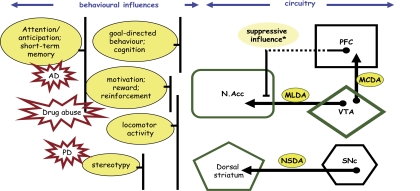Fig. 3.
Simplified schema describing the main components of midbrain dopaminergic systems (circuitry), the behavioral domains they influence, and association of their malfunction with some CNS disorders. The NSDA (or mesostriatal) system has its origins in the perikarya of the SNc and projects to the dorsal striatum. This regulates locomotor activity and is involved in stereotypical behaviors (e.g., grooming and gnawing in rats). The NSDA pathway degenerates in Parkinson's disease. The mesolimbic dopaminergic system (MLDA) originates in the perikarya of the ventral tegmental area (VTA) and projects to the ventral striatum, especially the N.Acc. This pathway also has some influence on locomotor behavior and is involved primarily in regulating motivation, reward, and reinforcement. Altered activity in the MLDA is associated with addictive behaviors and drug abuse. Perikarya in the VTA also project to the PFC, forming the mesocortical dopaminergic system (MCDA) involved in higher cognitive functions, which may deteriorate in AD. Release of DA from the VTA projections to the PFC trans-synaptically attenuates subcortical/mesoaccumbens DA activity and N.Acc DA release; hypofunction in the mesocortical dopaminergic system and hyperfunction in the MLDA activity to the N.Acc is characteristic of schizophrenia.

